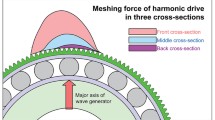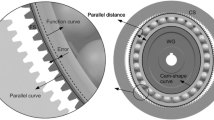Abstract
Meshing backlash mainly determines the transmission accuracy of harmonic drive, which is an important index in design. In this paper, a design method for short tooth involute profile is proposed. By intercepting part of the tooth profile, meshing interference of the addendum can be effectively avoided. Based on the dimensions of over pins of circular spline and flexspline, a calculation method of tooth thickness deviation is proposed, and the positive and negative tooth thickness deviation are defined. Involute functions need not be calculated by this method, which simplifies the solution process. By discretizing the teeth profile points of circular spline and flexspline, a calculation method of time-varying backlash is proposed, the variation of backlash in meshing in and out is analyzed, and the influence law of tooth thickness deviation on backlash is studied. On this basis, an algorithm for adjusting the radial deformation to compensate for the backlash is proposed. The results show that the excessive backlash in the meshing area can be reduced by increasing the radial deformation. When meshing interference occurs, the interference-free meshing can be realized by decreasing the radial deformation.












Similar content being viewed by others
References
Pham, A., & Ahn, H. (2018). High precision reducers for industrial robots driving 4th industrial revolution: State of arts, analysis, design, performance evaluation and perspective. International Journal of Precision Engineering and Manufacturing-Green Technology, 5(4), 519–533.
Saerens, E., Crispel, S., García, P. L., Verstraten, T., Ducastel, V., Vanderborght, B., & Lefeber, D. (2019). Scaling laws for robotic transmissions. Mechanism and Machine Theory, 140, 601–621.
Qiu, Z., & Xue, J. (2021). Review of performance testing of high precision reducers for industrial robots. Measurement, 183, 109794.
Sahoo, V., & Maiti, R. (2018). Load sharing by tooth pairs ininvolute toothed harmonic drive with conventional wave generator cam. Meccanica, 2018(53), 373–394.
Dong, H., Ting, K., & Wang, D. (2011). Kinematic fundamentals of planar harmonic drives. ASME Journal of Mechanical Design, 133, 011007.
Dong, H., Wang, D., & Ting, K. (2011). Kinematic effect of the compliant cup in harmonic drives. ASME Journal of Mechanical Design, 133, 051004.
Chen, X., Liu, Y., Xing, J., Lin, S., & Xu, W. (2014). The parametric design of double-circular-arc tooth profile and its influence on the functional backlash of harmonic drive. Mechanism and Machine Theory, 73, 1–24.
Yang, C., Ma, H., Zhang, T., Liu, Z., Zhao, Y., & Hu, Q. (2021). Research on meshing characteristics of strain wave gearing with three different types of tooth profiles. International Journal of Precision Engineering and Manufacturing, 22, 1761–1775.
Yu, Z., Ling, S., Wang, X., & Wang, L. (2021). Study on tooth profile design of harmonic drive with deformation model of flexspline. Meccanica, 56, 1883–1904.
Song, C., Li, X., Yang, Y., & Sun, J. (2022). Parameter design of double-circular-arc tooth profile and its influence on meshing characteristics of harmonic drive. Mechanism and Machine Theory, 167, 104567.
León, D., Arzola, N., & Tovar, A. (2015). Statistical analysis of the influence of tooth geometry in the performance of a harmonic drive. Journal of the Brazilian Society of Mechanical Sciences and Engineering, 37, 723–735.
Yang, C., Hu, Q., Liu, Z., Zhao, Y., Cheng, Q., & Zhang, C. (2020). Analysis of the partial axial load of a very thin-walled spur-gear (Flexspline) of a harmonic drive. International Journal of Precision Engineering and Manufacturing, 21, 1333–1345.
Yao, Y., Chen, X., & Xing, J. (2020). Tooth effects on assembling bending stress offlexible tooth rim in harmonic drive. Mechanism and Machine Theory, 150, 103871.
Hrcek, S., Brumercik, F., Smetanka, L., Lukac, M., Patin, B., & Glowacz, A. (2021). Global sensitivity analysis of chosen harmonic drive parameters affecting its lost motion. Materials, 14, 5057.
Gao, W., Furukawa, M., Kiyono, S., & Yamazaki, H. (2004). Cutting error measurement of flexspline gears of harmonic speed reducers using laser probes. Precision Engineering, 28(3), 358–363.
Ma, D., Wu, J., Liu, T., & Yan, S. (2017). Deformation analysis of the flexspline of harmonic drive gears considering the driving speed effect using laser sensors. Science China Technological Sciences, 60, 1175–1187.
Ma, D., Wu, J., & Yan, S. (2016). A method for detection and quantification of meshing characteristics of harmonic drive gears using computer vision. Science China Technological Sciences, 59, 1305–1319.
Ma, D., Wang, R., Rao, P., Sui, R., & Yan, S. (2018). Automated analysis of meshing performance of harmonic drive gears under various operating conditions. IEEE Access, 6, 68137–68154.
Zhang, C., Song, Z., Liu, Z., Cheng, Q., Zhao, Y., Yang, C., & Liu, M. (2018). Tribological properties of flexspline materials regulated by micro-metallographic structure. Tribology International, 127, 177–186.
Zhang, C., Song, Z., Liu, Z., Cheng, Q., Zhao, Y., Yang, C., & Liu, M. (2019). Wear mechanism of flexspline materials regulated by novel amorphous/crystalline oxide form evolution at frictional interface. Tribology International, 135, 335–343.
Hu, Q., Liu, Z., Yang, C., & Xie, F. (2020). Research on dynamic transmission error of harmonic drive with uncertain parameters by an interval method. Precision Engineering, 68, 285–300.
Li, X., Song, C., Yang, Y., Zhu, C., & Liao, D. (2020). Optimal design of wave generator profile for harmonic gear drive using support function. Mechanism and Machine Theory, 152, 103941.
Yague-Spaude, E., Gonzalez-Perez, I., & Fuentes-Aznar, A. (2020). Stress analysis of strain wave gear drives with four different geometries of wave generator. Meccanica, 55, 2285–2304.
Gravagno, F., Mucino, V. H., & Pennestrì, E. (2016). Influence of wave generator profile on the pure kinematic error and centrodes of harmonic drive. Mechanism and Machine Theory, 104, 100–117.
Yao, Y., Chen, X., Xing, J., Shi, L., & Wang, Y. (2021). Tooth position and deformation of flexspline assembled with cam in harmonic drive based on force analysis. Chinese Journal of Mechanical Engineering, 34(1), 1–20.
Jia, H., Li, J., Xiang, G., Wang, J., Xiao, K., & Han, Y. (2021). Modeling and analysis of pure kinematic error in harmonic drive. Mechanism and Machine Theory, 155, 104122.
Yu, W., Mechefske, C., & Timusk, M. (2016). Influence of the addendum modification on spur gear back-side mesh stiffness and dynamics. Journal of Sound and Vibration, 389, 183–201.
Zhan, J., Fard, M., & Jazar, R. (2015). Iterative computation for measurement over pins of gears. Measurement, 63, 252–258.
Funding
The authors would like to thank the National Natural Science Foundation of China No. 52175447 and National Key Research and Development Program of China No. 2020YFB2008200 for supporting the research. China Postdoctoral Science Foundation No. 2021M700301.
Author information
Authors and Affiliations
Contributions
All authors read and approved the final manuscript.
Corresponding author
Ethics declarations
Competing interest
The authors declare no competing financial interests.
Additional information
Publisher's Note
Springer Nature remains neutral with regard to jurisdictional claims in published maps and institutional affiliations.
Rights and permissions
Springer Nature or its licensor (e.g. a society or other partner) holds exclusive rights to this article under a publishing agreement with the author(s) or other rightsholder(s); author self-archiving of the accepted manuscript version of this article is solely governed by the terms of such publishing agreement and applicable law.
About this article
Cite this article
Yang, C., Ma, H., Zhang, T. et al. Calculation of Tooth Thickness Errors and Its Adjustment on Meshing Backlash of Harmonic Drive. Int. J. Precis. Eng. Manuf. 24, 289–301 (2023). https://doi.org/10.1007/s12541-022-00738-8
Received:
Revised:
Accepted:
Published:
Issue Date:
DOI: https://doi.org/10.1007/s12541-022-00738-8




